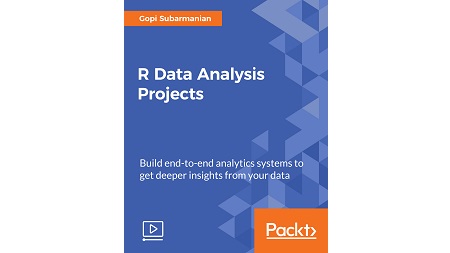
English | MP4 | AVC 1920×1080 | AAC 48KHz 2ch | 4h 08m | 962 MB
Get valuable insights from your data by building data analysis systems from scratch with R
R offers a large variety of packages and libraries for fast and accurate data analysis and visualization. As a result, it’s one of the most popularly used languages by data scientists and analysts, or anyone who wants to perform data analysis.
This video will demonstrate how you can put to use your existing knowledge of data analysis in R to build highly efficient, end-to-end data analysis pipelines without any hassle. You’ll start by building a content-based recommendation system, followed by building a project on sentiment analysis with tweets.
You’ll implement time-series modeling for anomaly detection and understand cluster analysis for streaming data. You’ll work through projects on performing efficient market data research, building recommendation systems, and analyzing networks accurately, all provided with easy to follow code.
With the help of these real-world projects, you’ll get a better understanding of the challenges faced when building data analysis pipelines, and see how you can overcome them without compromising on the efficiency or accuracy of your systems. The video covers some popularly used R packages such as dplyr, ggplot2, RShiny, and others, and includes tips on using them effectively.
By the end of this video, you’ll have a better understanding of data analysis with R, and will be able to put your knowledge to practical use without any hassle.
This video takes a unique, learn-as-you-do approach, as you build on your understanding of data analysis progressively with each project. This video is designed in a way that implementing each project will empower you with a unique skill set, and enable you to implement the next project more confidently.
What You Will Learn
- Build end-to-end predictive analytics systems in R
- Study an experimental design to gather data and conduct analysis
- Implement a recommender system from scratch using different approaches
- Use and leverage RShiny to build reactive programming applications
- Build systems for varied domains including market research, network analysis, social
media analysis, and more - Explore various R Packages such as RShiny, ggplot, recommenderlab, dplyr, and find out how to use them effectively
- Communicate modeling results using Shiny Dashboards
- Perform multi-variate time-series analysis prediction, supplemented with sensitivity analysis and risk modeling
Table of Contents
Association Rule Mining
1 The Course Overview
2 Understanding the Recommender Systems
3 Association Rule Mining and Cross-Selling Campaign
4 Weighted Association Rule Mining
5 Hyperlink-Induced Topic Search
6 Negative Association Rules
7 Rules Visualization and Wrapping Up
Fuzzy Logic Induced Content-Based Recommendation
8 Introducing Content-Based Recommendation
9 News Aggregator Use Case and Data
10 Designing the Content-Based Recommendation Engine – Similarity Index
11 Designing the Content-Based Recommendation Engine – Searching
Collaborative Filtering
12 Introduction to Collaborative Filtering
13 recommenderlab Package
14 Collaborative Filtering Use Case and Data
15 Designing and Implementing Collaborative Filtering
Twitter Text Sentiment Classification
16 Kernel Density Estimation
17 Twitter Text and Sentiment Classification
18 Dictionary Based Scoring
19 Text Pre-Processing
20 Building a Sentiment Classifier
21 Assembling an R Shiny Application
Record Linkage – Stochastic and Machine Learning Approaches
22 Demonstrating the Use of RecordLinkage Package
23 Stochastic Record Linkage
24 Machine Learning-Based Record Linkage
25 Building an R Shiny Application – Record Linkage
Streaming Data Clustering Analysis in R
26 Introducing Stream Clustering
27 Introducing the stream Package
28 Data Clustering Use Case
Analyze and Understand Networks Using R
29 Graphs in R
30 Use Case and Data Preparation
31 Product Network Analysis
32 Building an R Shiny Application – Networks
Taming Time Series Data Using Deep Neural Networks
33 Time Series Data
34 Deep Neural Networks
35 Introduction to the MXNet R Package
36 Symbolic Programming in MXNet
37 Training Test Split
Resolve the captcha to access the links!